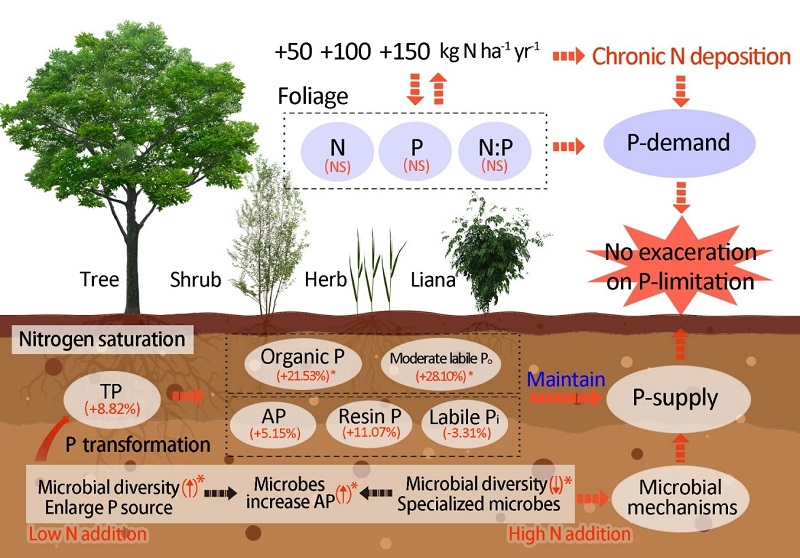

In recent decades, nitrogen deposition has exerted a substantial impact on biogeochemical cycles of terrestrial ecosystems across the globe. While phosphorus is a vital macronutrient necessary for all organisms, it assumes a crucial role in physiological processes associated with protein and genetic material synthesis, energy transfer, membrane formation and stability. Despite this fact, in heavily weathered soils in tropical and subtropical areas, phosphorous scarcity constrains ecological processes and limits ecosystem primary productivity. Therefore, it is important to explore the phosphorus demands of tropical forest plants and the transformations in soil phosphorus fractions associated with nitrogen deposition. This study has implications not only for understanding the impact of nitrogen deposition on phosphorus cycling of forest ecosystem but also for the guidance of policy-development aimed at achieving sustainable forest management and environmental conservation through appropriate biogeochemical assays.
The study was conducted by Dr. Yu Guangcan from the Ecological Center of South China Botanical Garden with the guidance of Prof. Yan Junhua, Prof. Wang Yingping, and Associated Prof. Zheng Mianhai. Based on the long-term experimental platforms in a typical subtropical evergreen broad-leafed forest in Dinghushan Nature Reserve, Guangdong, we explored the impacts of 18-year nitrogen additions on leaf phosphorus of four plant life-forms (tree, shrub, herb and liana), phosphorus fractions and other physicochemical properties of bulk and rhizosphere soils, which was aimed to uncover the potential effects and regulation mechanisms of long-term nitrogen addition on the phosphorus dynamics in nitrogen-rich subtropical forests. The study found that three nitrogen addition rates did not significantly alter the nitrogen/phosphorus concentration nor its ratio of leaves of the four plant life-forms, and did not diminish the total and available phosphorus content of the rhizosphere soil. This finding is contrary to the conventional view that extended exposure to nitrogen deposition aggravates forest phosphorus limitation. The underlying mechanism is that plants did not increase nitrogen uptakes therefore nor increase phosphorus uptakes (to maintain a stable leaf nitrogen: phosphorus stoichiometry) after adapting to high nitrogen availability in an already nitrogen-saturated ecosystem. Furthermore, different nitrogen addition rates regulated soil phosphorus transformation via microbial community transition: Low nitrogen addition rate significantly increased soil microbial taxonomic diversity, and a higher microbial diversity could enlarge the sources of nutrient acquisition and stimulated decomposition of recalcitrant organic matters; while high nitrogen addition rate significantly decreased soil microbial taxonomic diversity, and the remaining microorganisms screened by nitrogen-rich environments demonstrated characteristics resistant to hostile environmental conditions and maintained an efficient phosphorus acquisition capacity. These findings help improve the understanding of plant phosphorus acquisition and modelling of biogeochemical nitrogen–phosphorus cycling and vegetation productivity in nitrogen-rich forest ecosystems, particularly considering the fact that chronic nitrogen deposition may likely lead to soil N richness and even saturation of many forests in the future.
The paper entitled "Eighteen-year nitrogen addition does not increase plant phosphorus demand in a nitrogen-saturated tropical forest" was recently published in the Journal of Ecology (IF5-year=7.164, JCI Ecology ranking 15/189). Dr. Yu Guangcan is the first author of the paper, and Prof. Yan Junhua and associate Prof. Zheng Mianhai were co-corresponding authors. The research was financially supported by the National Science Fund for Distinguished Young Scholars (41825020), Youth Innovation Promotion Association of the Chinese Academy of Sciences (2021346), the National Natural Science Foundation of China (31901164, 31901296), the Guangdong Basic and Applied Basic Research Foundation (2021A1515012147, 2021A1515010652), Youth Elite Sponsorship Program by ESC (STQT2020A02) and the Guangzhou Basic and Applied Basic Research Foundation (202201010449). Link to the article: http://doi.org/10.1111/1365-2745.14118

Figure 1 A schematic diagram showing the influences of 18-year?N addition on phosphorus fractions and transformation in rhizosphere soils of four plant life-forms

